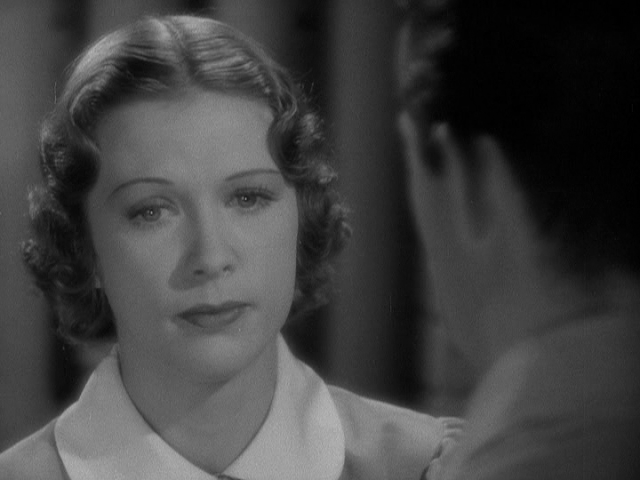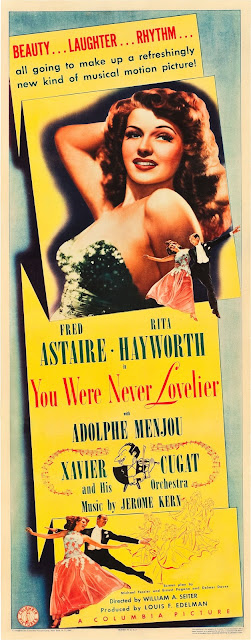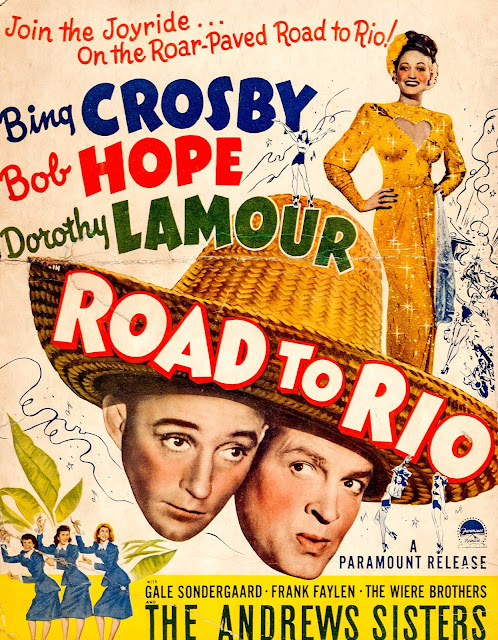Judy Garland proves her mettle in... Broadway Melody of 1938 (1937)
After the success of 1929's The Broadway Melody, the first talkie to win Best Picture, MGM made a whole series of "Broadway Melody" films. While none of them have the same characters, the films are similar in their plots about backstage musicals and MGM always made sure they were full of glitz, glamour, and talent. Roy del Ruth's Broadway Melody of 1938 is a perfect example of this. Starring Robert Taylor, Eleanor Powell, Judy Garland, Sophie Tucker, Buddy Ebsen, George Murphy, and more, this movie is filled with bouncy musical numbers, beautiful cinematography, a nice score comprised of mostly Arthur Freed and Nacio Herb Brown tunes, and some truly impressive moments.
I'll be honest: when I started writing this post, I thought I had already seen Broadway Melody of 1938 only to realize that I had confused it for the movie that came before it, Broadway Melody of 1936, which also features Powell, Taylor, and Ebsen, plus another score by Brown and Freed. Admittedly, I enjoy 1936 more than 1938 (two words: Una Merkel), but 1938 is still good entertainment.
The plot is fairly thin. George Murphy and Buddy Ebsen are best friends and ex-vaudevillians who get jobs taking care of prized racehorse Star Gazer. The boys are soon joined by Powell; she raised the horse and was forced to sell him to wealthy Binnie Barnes and her husband, Raymond Walburn. Barnes and Walburn are also the backers for producer Taylor's newest Broadway show. After seeing Powell dance around with Murphy and Ebsen, Taylor chooses her as his star, to Barnes's great annoyance. Complications quickly ensue, thanks to a love triangle, money troubles, and Barnes's machinations.
Although 1938 has some issues -- the dialogue could be snappier, some of the songs are forgettable, Robert Benchley is given nothing to do -- there were a few highlights for me. For starters, Robert Taylor is very easy on the eyes. Okay, fine, he does well at the acting stuff, too, but let's not pretend we aren't all Barnes's character when she first sees Taylor:
Despite his pretty face, though, Broadway Melody of 1938 is, without a doubt, Eleanor Powell's film. She is in almost every scene; she gets the majority of the musical numbers (with her singing dubbed by Marjorie Lane); and she receives one stunning close-up after the next:
I've admired Powell from the first time I saw her, but I was always a little disappointed that she never seemed to do any romantic duets with her dancing partners. Don't get me wrong -- I love that Powell could match taps with any man and she was given the same freedom as Fred Astaire in regards to her choreography. (She could even wear a tuxedo as well as him!) But I was still delighted to see 1938 present "I'm Feelin' Like a Million," a magical, lively routine between Powell and Murphy. Watch the dance here and try not to smile as the duo tap and twirl their way through a thunderstorm, a scenario that just might have been inspired by "Isn't it a Lovely Day?" from Top Hat.
Murphy and Powell would dance together again in Broadway Melody of 1940, but I find Murphy's character much more likable in 1938. He and Powell had good chemistry; their scenes together are often breezy and fun. It's a real testament to Murphy's dancing abilities that he was able to keep up with tap queen Powell.
Another man who could dance side by side with Powell was Buddy Ebsen. Like many people, I grew up knowing the actor as Jed Clampett, so it's been interesting to learn about his filmography. It's a little strange, too -- Jed Clampett was always the calm, rational patriarch, but in films like 1936 and 1938, he is way more eccentric. He is still the slow-talking, contemplative, small-town guy, but his facial expressions and the way he moves his body while dancing are just so weird and unique. Take a look at this snippet from "Follow in My Footsteps" and tell me I'm wrong. On a side note, I am super jealous of Ebsen's Donald Duck shirt in 1938. He also wears a Mickey Mouse sweater in 1936 that is too amazing for words.
Out of everyone in the movie, Judy Garland fared the best with critics, audiences, and even her fellow castmates. As Ebsen remembered, "One day Arthur Freed came into the rehearsal hall and said, 'Meet your new dancing partner!' And there was this gangly [fourteen]-year-old, Judy Garland. She was very friendly, very easy to get along with, and very talented. She was a sensation in Broadway Melody; that established her as someone who was to be reckoned with. And I taught her the little shim-sham-shimmy number which we did together in the finale."
Tucker also praised Garland in her frank assessment of the film: "The picture wasn't good, and I was only fair. ... Judy Garland was the only one in the whole cast in whom I saw great possibilities. I said so to L.B. [Mayer] and to everyone on the lot. ... My predictions were right!" Tucker and Garland got along beautifully. "Do you know what Miss Tucker did? She gave up her lunch hour every day to coach me," Garland recalled. "She taught me every trick she had learned from her years as a stage star. If I do put a song over, it's because of Sophie Tucker." Tucker and Garland would work together again that same year in Thoroughbreds Don't Cry.
1938 gave Garland one of her most iconic moments: passionately singing "Dear Mr. Gable/You Made Me Love You" to photographs of Clark Gable. Before 1938, the remarkable child star had really only done two projects of substance at MGM: Every Sunday (1936), an infamous short she did with Deanna Durbin that led to MGM keeping her and sending Durbin to Universal, and Pigskin Parade (1936), a cute little musical that has sunk into obscurity. The number "Dear Mr. Gable" was a major stepping stone for Garland -- audiences adored it, and MGM took notice.
James V. Monaco and Joseph McCarthy's "You Made Me Love You" was first published in 1913 and introduced by Al Jolson in the Broadway revue The Honeymoon Express. Over two decades later, the song was still a well-known hit and was chosen by composer and arranger Roger Edens for Garland to sing at the birthday party MGM was throwing for Clark Gable. Although the young songstress wanted to go with an Ethel Merman torch song, her mentor Edens convinced her that Monaco and McCarthy's standard was a better fit. He then crafted special lyrics for the beginning of the song and a talking part that Garland says before singing the final chorus.
Tucker also praised Garland in her frank assessment of the film: "The picture wasn't good, and I was only fair. ... Judy Garland was the only one in the whole cast in whom I saw great possibilities. I said so to L.B. [Mayer] and to everyone on the lot. ... My predictions were right!" Tucker and Garland got along beautifully. "Do you know what Miss Tucker did? She gave up her lunch hour every day to coach me," Garland recalled. "She taught me every trick she had learned from her years as a stage star. If I do put a song over, it's because of Sophie Tucker." Tucker and Garland would work together again that same year in Thoroughbreds Don't Cry.
1938 gave Garland one of her most iconic moments: passionately singing "Dear Mr. Gable/You Made Me Love You" to photographs of Clark Gable. Before 1938, the remarkable child star had really only done two projects of substance at MGM: Every Sunday (1936), an infamous short she did with Deanna Durbin that led to MGM keeping her and sending Durbin to Universal, and Pigskin Parade (1936), a cute little musical that has sunk into obscurity. The number "Dear Mr. Gable" was a major stepping stone for Garland -- audiences adored it, and MGM took notice.
James V. Monaco and Joseph McCarthy's "You Made Me Love You" was first published in 1913 and introduced by Al Jolson in the Broadway revue The Honeymoon Express. Over two decades later, the song was still a well-known hit and was chosen by composer and arranger Roger Edens for Garland to sing at the birthday party MGM was throwing for Clark Gable. Although the young songstress wanted to go with an Ethel Merman torch song, her mentor Edens convinced her that Monaco and McCarthy's standard was a better fit. He then crafted special lyrics for the beginning of the song and a talking part that Garland says before singing the final chorus.
After her performance at the party, Louis B. Mayer was bowled over and demanded that the number be included in MGM's next musical. Once audiences fell in love with the number, too, the studio placed Garland in back-to-back films, Thoroughbreds Don't Cry and Everybody Sing (1938), the latter's title coming from one of the tunes Garland belted in 1938. "Dear Mr. Gable" also led to a single record and a contract with Decca Records.
Of her performance in the film, Garland said, "The only thing I didn't like about me in Broadway Melody was the first line I had to speak: 'Aw, the Claytons are a bunch of hams!' It was so precocious. I hate anything precocious; I'm not precocious at all." One of the biggest disappointments about 1938 is how little Garland's screen time is. Despite that, you can still see the sparkling comedienne and brilliant entertainer she was quickly becoming. I can only imagine how thrilled 1937 audiences felt seeing this performance and how they excitedly waited in anticipation for Garland's next film.
Broadway Melody of 1938 has its downsides, but there is still something irrepressibly exuberant about it. Even if I can't recall how "Everybody Sing" or "Your Broadway and My Broadway" goes, I can remember the joy of seeing Garland become a star or Powell doing her incredible feats of graceful athleticism. As I've come to learn, there is always something to be cherished in a classic film, regardless of whether it is good, bad, or just mediocre.
Of her performance in the film, Garland said, "The only thing I didn't like about me in Broadway Melody was the first line I had to speak: 'Aw, the Claytons are a bunch of hams!' It was so precocious. I hate anything precocious; I'm not precocious at all." One of the biggest disappointments about 1938 is how little Garland's screen time is. Despite that, you can still see the sparkling comedienne and brilliant entertainer she was quickly becoming. I can only imagine how thrilled 1937 audiences felt seeing this performance and how they excitedly waited in anticipation for Garland's next film.
Broadway Melody of 1938 has its downsides, but there is still something irrepressibly exuberant about it. Even if I can't recall how "Everybody Sing" or "Your Broadway and My Broadway" goes, I can remember the joy of seeing Garland become a star or Powell doing her incredible feats of graceful athleticism. As I've come to learn, there is always something to be cherished in a classic film, regardless of whether it is good, bad, or just mediocre.
__________________
This is my entry to the Second Annual Judy Garland Blogathon. Celebrate the marvelous Ms. Garland by checking out the other tributes here!




































































Comments
Post a Comment